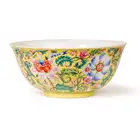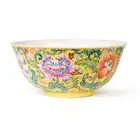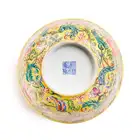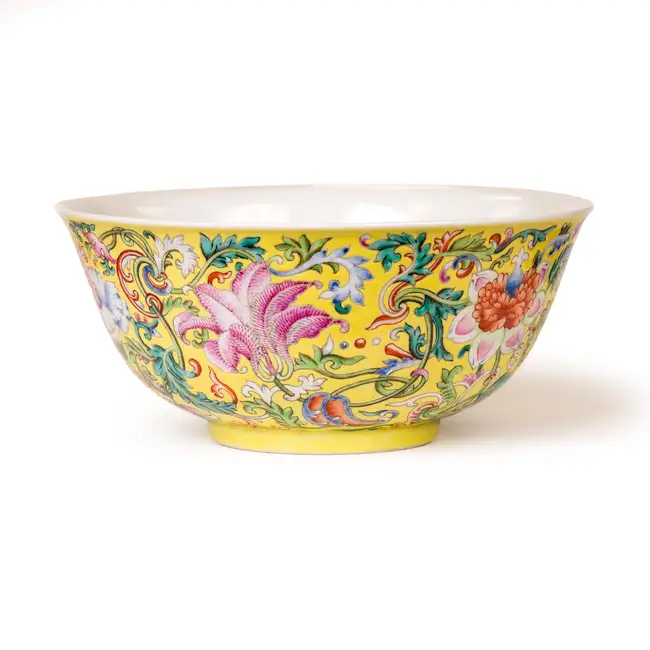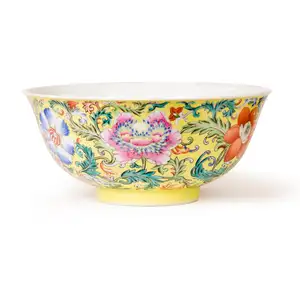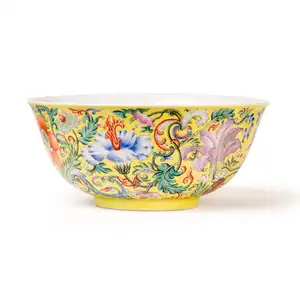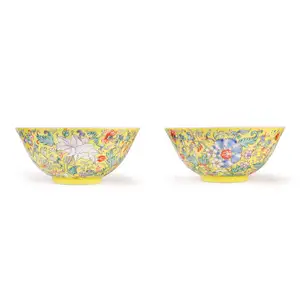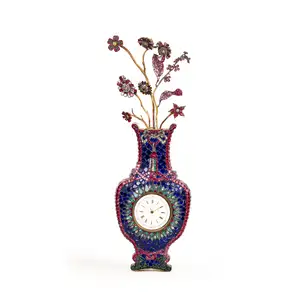Tuesday 29 October 2024
A large Chinese Imperial yangcai yellow-ground 'floral' bowl Qing dynasty, Daoguang mark and...
View MoreLot 25
Description
A large Chinese Imperial yangcai yellow-ground 'floral' bowl
Qing dynasty, Daoguang mark and period
Vividly enamelled around the body with a dense, leafy meander of scrolling blossoms and flowers in full bloom on a bright yellow ground, the interior with five iron-red bats in flight, the base with underglaze blue six-character seal mark, 18.5cm diameter.
清道光 黃地洋彩花卉紋盌,青花篆書「大清道光年製」款
Featuring an imaginary flower, known as 'baoxianghua', that combines elements of peony, pomegranate, chrysanthemum, lotus and other flowers and plants, to represent majesty and beauty, the magnificent enamelling on this group of bowls is a testament to the technical artistry and aesthetic mastery reached by the artisans of the Imperial workshops during the early to mid Qing dynasty. The decoration of the interior, with its five bats, wufu, represents a further auspicious wish for the owner to enjoy the 'Five Blessings' of longevity, health, wealth, love of virtue, and peaceful death.
The term Yangcai (洋彩) first appeared in the records of Tang Ying, Taosheng Jishi Bei (陶成纪事碑), written in the 13th year of Yongzheng, where yangcai is described as a new category of glazed and enamelled porcelain inspired by Western painted enamel on copper. A number of yangcai wares were produced, later to become Imperial tea and dining vessels.
Palace records report that on the thirteenth day of the tenth month of the second year of Qianlong’s reign (AD1737), the Emperor was presented with ten new designs, including that of the present bowl, listed as ‘yellow-ground yangcai Palace bowl with foreign flowers’ (洋彩黃地洋花宮碗) [中國第一歷史檔案館, 香港中文大學文物館合編., 中國第一歷史檔案館., 香港中文大學文物館., (Archives of the Qing Imperial Household Department) Xianggang Zhong wen da xue wen wu guan he bian Zhongguo di yi li shi dang an guan, Zhongguo di yi li shi dang an guan, and Chinese University of Hong Kong Art Museum. 2005. 清宮內務府造辦處檔案總匯. Di 1 ban. Beijing: 人民出版社., 清宮內務府造辦處檔案匯總,vol. 7, 1736 – 1737年, pp. 797-798.].
Qianlong was so enamoured with the magnificent composition of baroque, scrolling flowers, that not only did he approve the production of this type of bowl in greater numbers, ordering: ‘this is a very good bowl, make more (洋彩黄地洋花宫碗甚好,再燒造些)’, but he also requested that the pattern be applied to boxes and covers, and vases.
During the reign of Daoguang, bowls of this pattern are thought to be referred to as ‘five-bats enamel bowls’. They are present in the records of the Imperial Palace archives from as early as the twelfth month of the first year of Daoguang’s reign (AD1821), when the records report that ‘(the Imperial Household Department) received a new shipment from Jiujiang, pieces with the Daoguang mark, including twenty large five-bat enamel bowls and thirty small five-bat enamel bowls.’ The following year, when the Guangchu Division of the Imperial Household Department instructed the Jiangjiu to relay to the Imperial Kiln a list of the wares needed for the Imperial Tea and Dining Room, this list included ‘large five-bat enamel bowls’ and ‘small five-bat’ enamel bowls, with the request to produce several pieces of each. This suggests that bowls of this pattern were produced exclusively for the Imperial Tea and Dining Room, at the explicit behest of the court.
Production of these bowls was stopped in the 28th year of Daoguang (AD1849), by Imperial order. That year, when presented by a minister with the memorial listing the suggested porcelain production order for the year, Emperor Daoguang expressed dissatisfaction with the burdensome arbitrary rules of the past regulating the seasonality of patterns of porcelain and requested that the production of sixteen wares in this list be stopped immediately. Amongst these was the five-bat, floral bowl.
Palace records indicate that these bowls were produced in two sizes, both featured in the present collection. Cf. An example of the smaller size (14.8 cm diameter) is a pair from the Fonthill Collection, sold at Christie's Hong Kong, 1 December 2010, lot 2892. The larger examples at 18.5 cm include a bowl in the collection of the Metropolitan Museum of Art, illustrated in Oriental Ceramics, The World's Great Collections, 1977, vol. 12, no. 163; a bowl in the Victoria and Albert Museum, accession no. C.292-1918, illustrated by R. Kerr, Porcelain of the Qing Dynasty, 1644-1911, London, 1986, pl. 106; and yet another bowl illustrated by J. Ayers, Chinese Ceramics in the Baur Collection, vol. 2, 1999, p. 234, no. 338 (A630).
See a pair of the larger sized bowls sold by Christies Hong Kong, 1 Jun 2011, lot 3655; a single bowl sold by Sotheby's New York, 21 March 2018, lot 544; and another also sold by Sotheby's New York, 13 September 2017, lot 34.
Lot Footnotes
此碗的紋飾以寶相花、牡丹、石榴、菊、蓮及各式花草為元素,秀麗且不失皇家威嚴,是清中早期御窯廠工匠達到超高造瓷技術和卓越美學造詣的證明。內部飾有五隻蝙蝠(五福),代表著長壽、健康、富裕、愛德和善終的吉祥願望。
洋彩一詞最早出現在唐英於雍正十三年間撰寫的《陶成紀事》中。他將洋彩描述為受西方銅胎畫琺瑯彩所啟發而新創的一種釉上彩。當時燒造了許多洋彩瓷器,其中多為御用茶器和膳食器。
據《造辦處活計檔》記載,乾隆二年十月十三日司庫劉山久、七品首領薩木哈、催總白世秀呈上十多种瓷器,其中 “洋彩黃地洋花宮碗”[1]便為此類碗。乾隆皇帝甚是喜愛這種巴洛克式卷草花卉構圖,檔案中記載:“黄地洋花宫碗甚好,再燒造些。”[2]並下旨將同類花卉構圖應用於瓶、蓋盒等進行裝飾。
這種圖案的碗在道光年間被稱為 “五蝠琺瑯磁碗”。道光元年十二月,《造辦處活計檔》有此種碗的記錄:“收得九江新到道光款……大五蝠琺瑯磁碗二十件,五蝠琺瑯小磁碗三十件。”
翌年,內務府廣儲司要求九江關轉達御窯廠燒造御茶膳房所需的瓷器清單中有“大五蝠琺瑯磁碗”、“五蝠琺瑯小磁碗”二項,要求“每樣燒十數件”的記載,此屬傳辦瓷器,等級頗高,專供“御茶膳房”使用。
道光二十八年大臣向皇帝呈上該年瓷器燒造的清單時,皇帝命停燒十六種瓷器,其中就包括此類碗。道光帝曾批復:“從前按節令按花紋之鄙例再不能除,些些小事就如是可恨可惡之至。總之有用之物不嫌共多,繁文些條如當力屏,初不在數十種瓷器也。”
據宮中檔案記載,此類碗有兩種尺寸,且都納於此私人收藏中。較小尺寸的碗(內徑14.8釐米)曾在香港佳士得2010 年 12 月 1 日《放山居》藏瓷拍賣中成對出售,為第2892號拍品。較大尺寸的碗(18.5釐米)藏於美國大都會博物館,收錄於1977年出版的《東方陶瓷》系列從書第十二冊,編號163;英國倫敦維多利亞女王與阿爾伯特博物館編號 C.292-1918,收錄於柯玫瑰於1986年出版的《清代瓷器1644 - 1911》一書中,圖版第106號。另一只碗收錄於J. 艾耶斯著錄的《鮑爾藏中國瓷器》第二冊,第234頁,第338號(A630)。
較大尺寸的一對碗請參見香港佳士得,2011年6月1日拍賣第3655號;紐約蘇富比,2018年3月21日拍賣第544號;以及紐約蘇富比,2017年9月13日拍賣第34號。
[1] 清宮内務府造辦處檔案總匯: 1729-1731。 (2005)。中國第一歷史檔案館, 香港中文大學文物館合編。China: 人民出版社。第七冊,第797-798頁。
[2] 同上。
Fees & VAT
Buyer's Premium
The buyer shall pay the hammer price together with a premium thereon of 26% up to £20,000 (31.2% inclusive of VAT), 25% from £20,001 - £500,000 (30% inclusive of VAT), 20% from £500,001 thereafter (24% inclusive of VAT). The premium price is subject to VAT at the standard rate.
VAT
VAT is not charged on the hammer price unless it is stated that there is 'VAT applicable on the hammer price at the end of the description. Buyer's premium is subject to VAT.(ARR) - ARTIST'S RESALE RIGHT
Qualifying living artists and the descendants of artists deceased within the last 70 years are entitled to receive a re-sale royalty each time their work is bought through an auction house or art market professional.
It applies to lots with hammer value over £1,000 as follows:
0 to £50,000 - 4%
£50,000.01 to £200,000 - 3%
£200,000.01 to £350,000 - 1%
£350,000.01 to £500,000 - 0.5%
Exceeding £500,000 - 0.25%
ARR is capped at £12,500
Please note ARR is calculated in euros. Auctioneers will apply current exchange rates.
Export of goods
Buyers intending to export goods should ascertain whether an export licence is required before bidding. Export licences are issued by Arts Council England and application forms can be obtained from its Export Licensing Unit. Details can be found on the ACE website www.artscouncil.org.uk or by phoning ACE on 020 7973 5188. The need for import licences varies from country to country and you should acquaint yourself with all relevant local requirements and provisions before bidding. The refusal of any such licences shall not permit the cancelling of any sale nor allow any delay in making full payment for the lot.
Own a similar item?
Request a ValuationReceive alerts about similar lots
Get StartedContinue Browsing
LOT 26
A large Chinese Imperial yangcai yellow-ground 'floral' bowl Qing dynasty, Daoguang mark and...
Estimate: £60000 - £80000
LOT 27
A large Chinese Imperial yangcai yellow-ground 'floral' bowl Qing dynasty, Daoguang mark and...
Estimate: £60000 - £80000
LOT 28
A large Chinese Imperial yangcai yellow-ground 'floral' bowl Qing dynasty, Daoguang mark and...
Estimate: £20000 - £30000
LOT 29
A pair of Chinese Imperial yangcai yellow-ground 'floral' bowls Qing dynasty, Daoguang marks and...
Estimate: £40000 - £60000
LOT 30
A Chinese glass paste embellished gilt metal wall clock Qing dynasty, Qianlong period Formed as...
Estimate: £8000 - £12000
LOT 31
A pair of Chinese Imperial zitan and reverse painted glass hanging lanterns and stands Qing...
Estimate: £80000 - £120000
 Newsletter Signup
Newsletter Signup
 Keyword Alerts
Keyword Alerts
Would you like to receive personalised keyword alerts when new catalogues go live. If so, please indicate these below
Set a password to save your keyword alerts
Passwords are a minimum of 7 characters and must include an upper case letter, a lower case letter, a number and a special character (e.g., !@#$%^&*).



